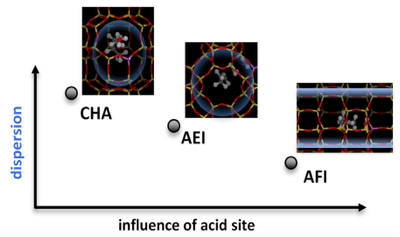Transition-state enthalpies in methanol-olefin reactions scale linearly with ammonia adsorption enthalpy as descriptor of acid site reactivity in zeotype catalysts. The slopes of these scaling relations decrease with increasing confinement stabilization by the framework.
Zeolite acid catalysts are extensively used in the chemical industry, popular due to their shape-selectivity and superior activity. This activity is determined by interplay between acid strength and a porous framework with molecular-sized voids. It remains a challenge to understand this interplay and use it to improve catalytic performance.
Researchers at SUNCAT have now reported a descriptor-based investigation of zeolite acid catalysts. The key property is the reactivity of a Brønsted acid site; how readily the site donates a proton to and stabilizes resulting positively charged transition states and intermediates. This reactivity can be quantified through the ammonia heat of adsorption, ∆HNH3, at the acid site. Focusing on alkene-methanol reactions, 21 zeotype catalysts of 3 different framework topologies have been investigated. It was possible to establish enthalpy-scaling relations for several transition-states across all materials, showing the robustness of the approach.
The results indicate that when the framework increasingly stabilizes cation-like transition states, they are less sensitive to changes in acid-site reactivity. This finding can be explained by the fact that when two charges of opposite sign (the transition state and the deprotonated acid site) are placed in a polarizable medium (the framework), the ion-pair interaction is weakened. In general, cation-like transition states determine the activity in solid acid catalysis, and it is hence of interest to investigate if the findings for methanol-olefin reactions apply in other cases.
The work illustrates the descriptor-based approach as a promising way of extracting trends in zeolite acid catalysis. This is of outmost importance to achieve the ultimate goal of tailoring the activity of zeolite acid catalysts, by choice of framework topology and acid strength.

